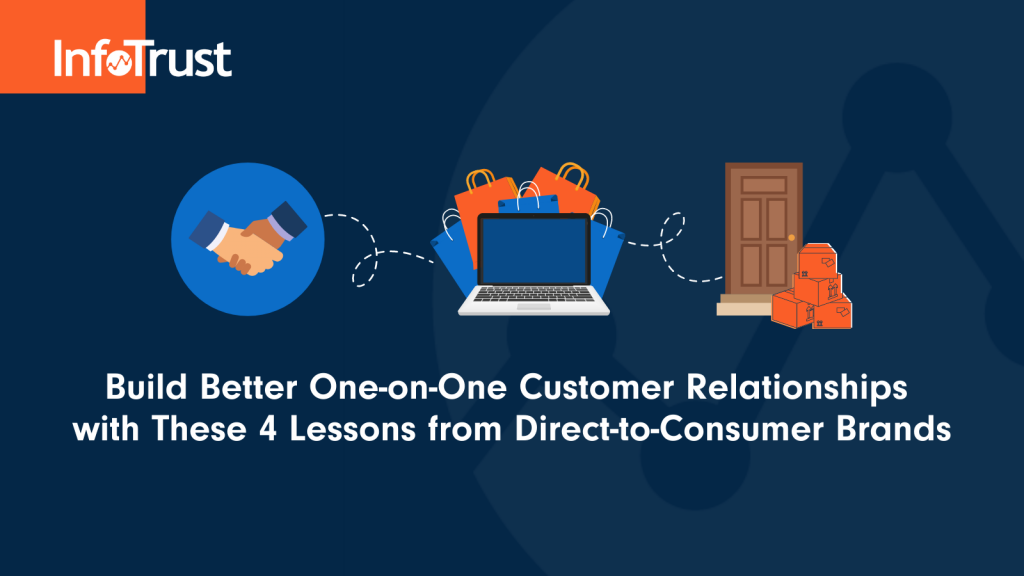While it’s common for consumer packaged goods (CPG) companies to consider transitioning to a direct-to-consumer (D2C) model, I find that many fail to do so for the right reasons. Or, at least, they aren’t taking full advantage of the benefits they could derive from a D2C model. Successful D2C isn’t just about selling more products or cutting out the middleman. It’s about deepening your company’s one-on-one relationship with customers.
Before you hop on the D2C bandwagon, I suggest you slow down and take time to consider what will add value for your ideal customer. Maybe they don’t need another eCommerce website or subscription service, and perhaps you can meet their needs without a costly overhaul of your business model.
Whatever your business decides, you can still learn some valuable lessons from successful D2C brands about how to build loyal, lasting connections with customers. Read on to discover the top four ways that D2C companies have harnessed the power of one-on-one marketing to improve their customer experiences and enhance their bottom line.
1. Create Knowledge Hubs
An effective way to build one-on-one relationships with your customers is to become their go-to source for information. Your website and content can provide helpful information to your target audience, which will allow them to develop trust and loyalty in your brand over time. For example, parents don’t just visit the Pampers website to buy diapers; they go to be educated about issues relevant to potty-training and childcare.
In many ways, CPG organizations are in a better position to create knowledge hubs because they can hire a professional content staff and create a lot of media. This was the case with Colgate, who paired their launch of a smart electric toothbrush with content focused on oral care. Even though most customers still purchased their toothbrushes from a regular grocery store, many visited Colgate’s website to find information and establish a one-on-one interaction with the brand. In return, Colgate was able to test different messages and collect data on how consumers interacted with their content.
Even if CPG companies make the choice not to sell D2C, they can still benefit from direct interactions with their customers. Patrón is a great example; the tequila company developed a digital “Cocktail Lab,” a data-driven cocktail recommendation engine. Based on the customer’s preferences, the Cocktail Lab serves up creative cocktail recipes, all while educating customers and keeping Patrón top-of-mind.
I’m sure that Patrón doesn’t want the hassle of selling alcohol directly to consumers and having to navigate shipping, liquor laws, and all the related headaches, but they still use D2C tactics to connect with customers. Simply put, CPG companies can still focus on direct-to-consumer interaction even if they aren’t interested in direct-to-consumer fulfillment.
2. Build a Distinctive Digital Store
For CPG companies interested in shifting to a D2C model, it’s beneficial to think about how you plan to sell or package your products. Instead of slapping a “buy” link on the company’s website, consider how you can create a digital store that provides a unique and fulfilling shopping experience.
PepsiCo has done this beautifully with their two D2C websites, Snacks.com and Pantry Shop. PepsiCo was well aware that customers could buy their products at their local Kroger or online through Amazon, so they had to figure out what would entice customers to use their digital stores. PepsiCo leveraged their extensive range of snack products, which includes brands like Lay’s, Cheetos, and Ruffles, in a creative way. When you visit Snacks.com, you’re able to search by different types of flavors, which offers a unique experience and a deeper engagement with the product range.
Additionally, PepsiCo has built their sites on the idea that customers can create a unique mix of products they’re not able to find elsewhere. Snacks.com offers exclusive products, like a Doritos beanie, and bundles, like a holiday snack pack and sweater, while Pantry Shop offers “pantry kits” in categories like “Rise and Shine” and “Workout and Recovery.” PepsiCo has bundled their goods in a way that stands out from a shopper’s experience in stores or on other websites.
3. Curate Your Products
The case of Objective Wellness provides a powerful lesson in product curation. Clorox—the owners of the Objective Wellness brand—realized that their customers probably wouldn’t get excited about buying bleach online, so they were careful about what they chose to sell directly to consumers.
Objective Wellness is a digitally-native line of dietary supplements that offers a highly-limited array of products. The products have simple, snappy names like “Focus + Clarity,” “Immune + Wellness,” and “Everything Armor,” and they’re curated to appeal to a younger demographic’s needs. If your company is considering making the move to D2C, make sure you’re choosing the right products before you launch.
When executed correctly, subscriptions are an effective way for CPG companies to directly and repeatedly earn revenue—but the emphasis here should be on “correctly.” Most consumers aren’t looking to receive 20 subscription boxes in the mail each month, so in order to succeed, your subscriptions must offer curated items tailored to your customers’ needs.
Subscription models help CPG organizations determine which items customers want on a regular basis, what types of items they are most interested in, and customers’ buying and shipping preferences. This data can deepen a company’s relationship with its customers, which, in turn, makes customers more loyal.
4. Personalize Your D2C
There’s no better way to build a one-on-one relationship with a customer than to offer them personalized products. Personalization also allows organizations to develop detailed insights about customers’ preferences, needs, and desires. Most CPG companies have the added benefit of engaging directly with consumers during the testing and development phases of their products, which gives them a crystal-clear perspective on what consumers are actually interested in buying.
Purina harnessed the power of personalization by building a completely personalized shopping experience for dog lovers. Customers create a profile for their pet, listing the animal’s age, health needs, tastes, and preferences. Then, Purina provides owners with food recommendations based on their dog’s specific nutritional needs and delivers the customized food straight to the owner’s doorstep. It doesn’t get much more one-on-one than that.
As you can see, personalization is closely related to building an educational hub for consumers, but instead of just providing educational content, this model takes the relationship one step further. It is specifically tailored to each individual. There is no way that Amazon could match the depth of this customer interaction, which makes consumers more likely to come directly to Purina.
Personalization may seem like a costly model to implement, but in reality, all the methods I’ve highlighted in this article can be highly cost-effective compared to other forms of market research and development. Do you remember the Super Bowl ad campaigns where junk food companies asked viewers to vote online for a new chip flavor? Today, you can get that kind of knowledge easily without having to pay millions of dollars for airtime.
Identify Your True Objectives
As we look at these different models, the important thing to keep in mind is that I am not suggesting the launch of D2C merely to sell products online. In fact, if that’s how big CPG companies are entering the D2C space, they will struggle. But if they are entering D2C as a way to gain deeper insights about their customers, they will be well positioned to succeed.
The data that you gain from one-on-one relationships can be leveraged in a variety of powerful ways. You can use those relationships to learn which new products or services will appeal to your customers. You can build even greater brand affinity, which will help you earn more lifetime value from your customers. And most importantly, having an open line of communication with your customers will help you adapt and innovate alongside their (and your) evolving needs.





